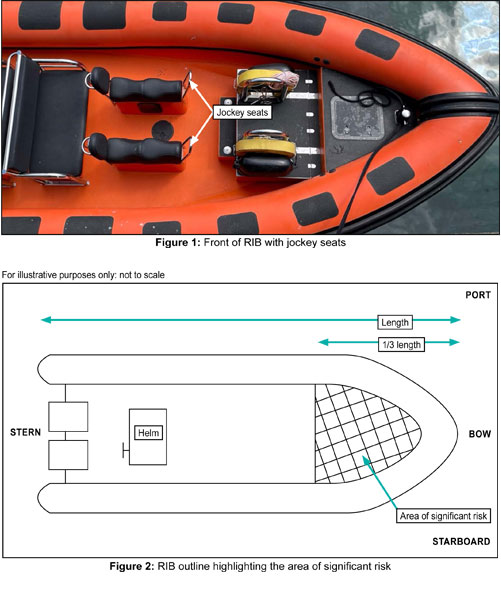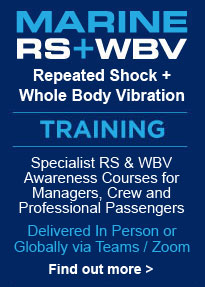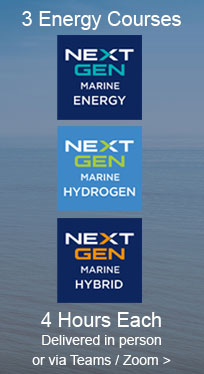MAIB Safety Bulletin - Injury on Sea Safari RIB

15.09.2023

MAIB Safety Bulletin
On 7 June 2023, a passenger on a rigid inflatable boat (RIB) sea safari suffered a spinal injury that left them paralysed from the waist downwards.
Twelve passengers had boarded the RIB and, once it was clear of the jetty, the two crew gave them a safety briefing and instruction on the wearing of lifejackets.
The RIB then proceeded out to sea and was increasing speed in choppy sea conditions when it encountered a steep-sided wave. The boat fell off the wave and slammed violently into the trough, dislodging a passenger from a forward jockey seat (Figure 1). The passenger immediately lost feeling in their legs.
The boat returned to the harbour and the casualty was removed by emergency services to an air ambulance and flown to hospital. There, diagnosis identified that the casualty had suffered a wedge compression fracture of the spine that left them with permanent paralysis below the waist. The passenger had no pre-existing conditions, was in good health and had normal bone mineral density (BMD).
The RIB was 3 years old, in good condition and certified under the Maritime and Coastguard Agency’s (MCA) Small Commercial Vessel (SCV) Code, which was an annex to Marine Guidance Note (MGN) 280 (M)1.
The RIB’s owner had several years’ experience operating this type of excursion, and the boat’s skipper was appropriately qualified.
The accident
The accident happened in weather conditions that the skipper considered favourable for the trip. Although the RIB was not travelling at high speed, as the bow pitched up on encountering waves it restricted the skipper’s view ahead. The steep-sided wave caught the skipper unaware and without time to mitigate the impact.
When the boat hit the trough, the resulting force applied to the passenger’s spine was of sufficient magnitude to fracture a vertebra. With a normal BMD level and no pre-existing conditions to increase their susceptibility to this type of injury, the factors contributing to the fracture related to the activity being undertaken. These included:
- the speed and movement of the RIB in the sea conditionsthe forward location of the seat that the passenger was using
- the passenger’s seated posture and their ability to react and compensate for the RIB’s motions
- the passenger’s awareness of the hazards associated with the RIB’s movement.
Wider context
Commercial passenger tours using RIBs, including sea safaris and thrill rides, have experienced a surge in popularity across the UK, with a corresponding increase in the occurrence of accidents. Since 2001, the MAIB has been notified of 54 accidents during RIB rides that have resulted in lower back injuries, 17 of which resulted in spinal fractures. Initial analysis of these previous accidents as part of this investigation indicates that passengers seated in the front third of a RIB’s overall length (Figure 2) are exposed to a significantly higher risk of lower back injuries than those seated further back, as the vertical motions experienced are generally greater towards the bow.
The passenger RIB industry has conducted research on shock mitigation and whole body vibration, primarily focused on high-speed operations, which has led to the development of codes of practice and seating designs. This accident, combined with the previous accident data, has highlighted concerns regarding the design, construction and location of seating on RIBs used for passenger operations, particularly when the seated individuals have little or no understanding of boat movement or how to mitigate its effects.
Small commercial high-speed craft guidance
In the UK, commercial RIBs carrying no more than 12 passengers to sea are certified to meet the standards set out in the SCV Code, but the conduct of operations and safety management are currently largely self-regulated.
In 2010, in response to an MAIB investigation report2, the Passenger Boat Association (PBA) and Royal Yachting Association (RYA) issued guidance on the safety of small high-speed passenger craft. In April 2019, issue 3 of the guidance was issued by the RYA, PBA and British Marine as the Passenger Safety on Small Commercial High Speed Craft & Experience Rides – A Voluntary Code of Practice (CoP). Additionally, in September 2021, MGN 436 (M+F)3 Amendment 2 was issued, which was further updated by Amendment 3 in July 2023.
Both the CoP and the MGN include guidance on seating location, design and shock mitigation. Also included is advice on the design of vessels, the posture and stability of occupants and the content of pre-departure briefings.
SAFETY LESSON
There is a significantly higher risk of spinal fractures to people seated in the front area of RIBs, regardless of speed.
Owners and operators of small commercial passenger vessels are strongly advised to:
-
Urgently review their operations and risk assessments, with reference to the CoP and MGN 436 (M+F). This review should assess and mitigate the risks associated with the requirement to seat passengers in the front area of a RIB and ensure that the risk assessment includes and addresses the variability of weather conditions and the ability of passengers.
-
Review their passenger pre-departure briefing and ensure that it includes a specific explanation of how to use the seat(s) and their associated handholds, including how to maintain the correct posture and stability to mitigate against injury.
Issued September 2023

All images are copyright Hybrid Marine Power 2024 unless otherwise stated.
This does not exclude the owner's assertion of copyright over the material.
eNews
09.07.2024
NEXT GEN Marine BATTERY Workshop via Teams
NEXT GEN Marine BATTERY Workshop is being held via…
Events
Southampton International Boat Show 2024
Dates:
13 to 22 September 2024
Location:
Southampton UK
eArticle
06.10.2023
Challenges of Unpredictable Marine Energy
From running Energy Transition training for significant maritime organisations technology…
Video
Round The World solar boat Turanor PlanetSolar
MS Tûranor PlanetSolar is the largest solar boat in the world. This 35 metre (115 feet) catamaran operates solely on…







